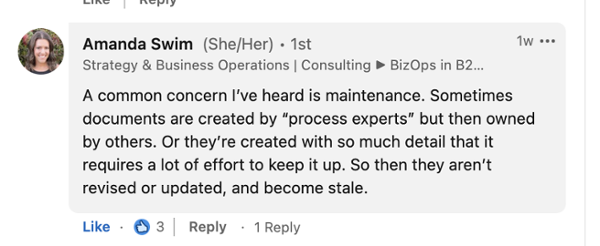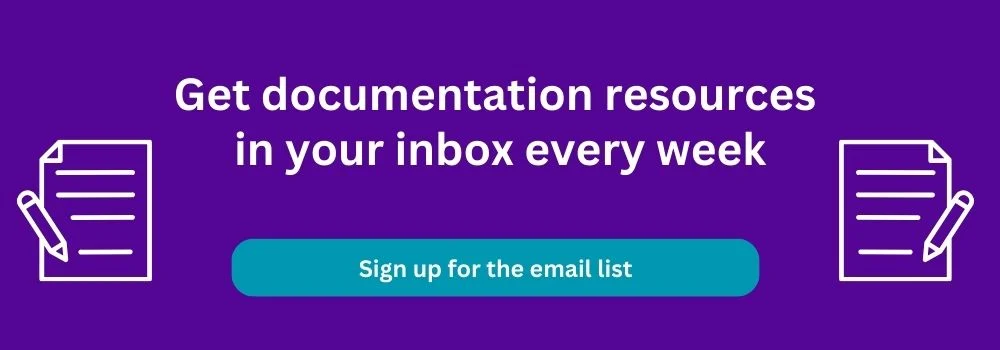Once you've started your process documentation efforts on your own, you may start to think about how to involve other people at your company in documentation.
At that point, you will probably receive pushback and objections from your team members or leaders.
Documenting your processes is not a normal behavior at most companies, so people may be afraid of change and not understand the benefits they will receive from this new way of working.
Though some of these objections may be similar to the roadblocks you personally faced when trying to begin your documentation, you'll need to be prepared with answers that discuss the benefits of this new behavior for each individual. The solution to your own personal objection or roadblock to starting documentation may not convince other people to become involved.
If you only read one thing in the article about overcoming objections, this is it:
Learn what the objecting person cares about, and explain how this change relates to what they care about.
In this case, the change is transforming a company that doesn't use or create documentation into a company where everyone is involved in some way, at least as users.
An example would be that leadership often cares about achieving business goals or department goals, so explain how documentation can help achieve those goals faster, more predictably, and more reliably.
Most objections can be grouped into one or more of these four categories:
Though many objections fall into more than one category, this first article will focus on time-related objections documentation.
Learn more about starting, writing, creating a system for maintenance, and more in this documentation guide.

Objection Example 1
“Our company is innovative, we move fast and break things, we don’t have time to document. It’s a waste of time.”
This is a common objection at a startup, even though the era of Facebook's mantra of "move fast and break things" supposedly has ended. Perhaps your team is still stuck in this mindset.
Here are some scripts you can use to overcome this objection. There are several to choose from, depending on the objecting person's interests.
"If you want to grow the business, we need documentation. It only takes a little more time upfront, using an efficient system I planned, to save us a lot more time in the future months compared to the amount of time spent documenting."
- Encourage people to think slightly longer-term than just putting out today's fires. You can talk about how you'll see some of the benefits in a few months by just spending a few hours this week getting started. Be aware that startup leaders often resist thinking or doing anything very long-term, such as years away, so talking about benefits in terms of months may help you overcome the objection.
"If you want to scale, we can’t rely on people transmitting information in real-time through Slack or in meetings every time our people need answers. That solution doesn’t scale when you add more people or more volume of requests as we hire and grow."
- Startup leaders love the word scale, so use it to your advantage!
"If we document our experiments as we break things, it will help us not repeat the time & mistakes of past tests. We can use past knowledge for context for future improvements to iterate and move even faster."
- Startup leaders love experiments and tests. Help them understand that documentation doesn’t mean processes are static and unable to change. Explain the concept of 'living documentation' and how you'll set up a system to keep it up-to-date.
Speaking of tests – getting the leader's support on a test or experiment of creating documentation may be a good first step if you have to overcome this objection, especially if you can measure the before-documentation and after-documentation results of the process.
Don’t give up after one “no.”
If at first you don’t succeed, try to get their buy-in again in a month or two.
Startup leaders may change their minds and their plans for the company often, so one "no" doesn’t mean "no" forever when you're in a fast-paced environment.
After the first "no," you could track all the issues you find that are a result of not having documentation. You could carefully communicate that information a few times as the issues appear, and soon you'll have data to show how much documentation would have helped specific situations.

Objection Example 2
“I don’t have time to create documentation or to ensure other people do it.”
This is a very common objection since efficient systems for documentation are rarely seen or discussed.
If you hear this objection, here are some phrases to overcome it. Choose the one that best fits what that specific objecting person cares about.
“Documentation reduces questions from others, giving you more time to do important, focused work.”
People often spend the majority of their day answering questions in meetings, email, or in messaging platforms. Many of these questions would not exist if people could self-serve answers with up-to-date, trusted documentation.
“Documentation reduces the errors that cause reactive fire-fighting daily, so you can spend more time achieving your goals.”
Gaining more time to spend on important, strategic work is a big benefit of documentation. Good documentation ends up creating more time for people in the long run, compared to the time it takes to draft and maintain. If someone is tired of their team making the same errors over and over, documentation can reduce the time and frustration spent fixing recurring problems.
“Documentation reduces the need for meetings. That will give you time back in your day.”
Many meetings are requested to get answers to questions that could be answered by documentation. The above defense will be especially true if you start a policy that all meetings need agendas and notes. These additional forms of documentation will not only reduce meeting requests from people who don't want to do the work of creating agendas and notes, it gets people into the writing and knowledge-sharing habit for the meetings that do occur.
“Documentation allows you to hire and onboard faster to relieve your workload sooner. It gives you more time to complete your most important work, instead of spending time on repetitive tasks and answering questions documentation could answer.”
Many leaders weigh the pros and cons of hiring someone to relieve their workload. Hiring could eventually give this person more time in their day (pro), after the initial extra time needed to train the new team member (con). If new team members are able to self-serve some of their training, or have documentation to rely on after an initial training, it will reduce the time input needed by the person delegating the work.
“Documentation allows you to coach and train more people in less time, helping advance your team so they are prepared for the work you delegate to them.”
Maybe your team doesn't have a budget to hire people right now, but you're still cross-training people or delegating work to them (to not only relieve your workload but to help them promote). Perhaps you've been wary of delegating your work because you'll know the time it takes to explain the task and constantly answer questions about it will be greater than the time saved by not doing the task yourself. Use documentation to make this experience smoother and more efficient for both sides, proving that documentation saves more time than it takes.
And to hint at the next objection:
“We’re setting up a system to make it easier to see if your team is using/creating it, so a documentation practice won’t add much extra time to your management routine.”
The project management, communication practices, and roles in the documentation system you'll set up will allow managers to efficiently help their team with accountability. Managers often only hold the role of documentation approver, to ensure the processes described in the documentation are being described as they want them to be run. This role takes less time than they might imagine.

Objection 3
"Even if I create it, I don't have time to keep it up-to-date. So why try?"
Maintenance time is a big objection that prevents people from starting documentation. This objection was suggested in a LinkedIn comment on a post about objections to documentation.

In other blog articles and in the courses, you will learn how to set up a system for easy maintenance and how to spread out the work so it's more manageable.
If you are just starting the communication part of setting up your system and haven't yet informed everyone of your efforts to make maintenance easy, here are a few ways to address this objection.
"I've been testing a system of maintenance for a few weeks/months now, to make sure it is realistic and efficient. I'm starting to ask other team members to help test it before rolling it out to the entire team/company. Would you like to be a beta tester? I value your opinion and feedback."
"We're splitting up the responsibilities into manageable pieces, so one person is not responsible for more than x articles or categories. This will reduce the maintenance time for each person. We're also working with managers to ensure the people responsible for creating or updating documentation are given time for this important work that may be part of promotions in the future."
"I've been using automated recurring tasks to remind me to complete quarterly reviews of each category of documentation that I am responsible for. I've also added blocks of time to my calendar for these reviews, to make sure the time is reserved. I can make sure these tools are set up for you as well. Ideally, we're making updates to documentation in real-time as processes change or are created, a few minutes at a time, but these quarterly reviews will help ensure nothing falls through the cracks and will help us identify larger improvements or gaps in documentation to fix."
"Since you'll start to use the documentation more often as you complete the processes, you'll notice places where updates may be necessary. If you're the editor for that topic, you can take a minute or two to complete the update right away instead of making a task for later. I'll show you how I've made it easy for the editors to make updates (share screen or send video of changing a sentence or two in the documentation). If you're not an editor, we'll have an easy communication channel set up for you to request changes in the document, if you notice it is outdated or unclear."
To get more personal, go back to the #1 tip in the introduction and frame your response to include a documentation benefit or a systems benefit you know they care about.
For example, if they want to receive more recognition for their work:
"Since editors like yourself will be communicating these updates and improvements using our team-or-company-wide communication routines, that will help your manager and team members recognize your efforts related to the process you're documenting."
Or if they're looking for more deep work time and fewer interruptions from team member questions:
"Creating and keeping the documentation up-to-date will reduce the number of questions that team members ask you, which interrupt your focused work. Often these questions are repetitive and could be answered by documentation... if the documentation is up-to-date, trusted, and communicated well. Taking just a few minutes to check and update the documentation every time you complete the process, and reserving more dedicated time once a quarter, will give you more focus time to complete work that will achieve your goals."
I hope that I've armed you with a few scripts and tactics to address common time objections to documentation.
Topics: Documentation



